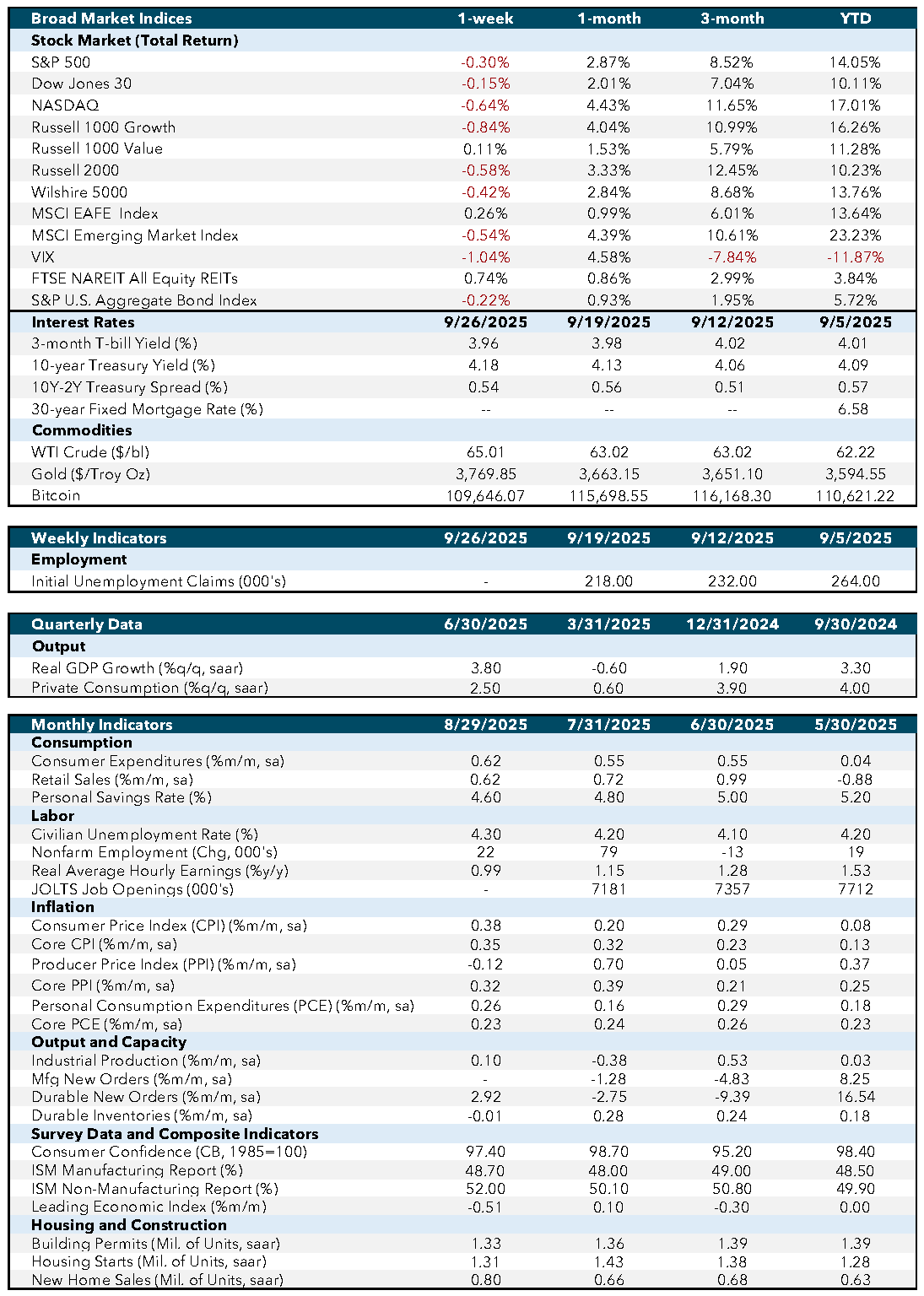Weekly Market Commentary
September 29th, 2025
Week in Review…
The week began with key sentiment data from the S&P Global Manufacturing and Services Purchasing Managers’ Indices (PMIs). Both readings came in slightly below market expectations and last month’s figures, suggesting some softening in forward-looking sentiment. However, with Manufacturing at 52.0 and Services at 53.9, both remain above the 50 threshold, signaling continued expansion in economic activity rather than contraction.
Housing Market Strength Surprises
Midweek brought encouraging news from the housing sector. Revised building permits data erased some of the prior week’s disappointment, while new home sales surged to 800,000, well above the 650,000 forecast. This represented a 20.5% month-over-month (MoM) increase compared to last month’s -1.8% decline. Similarly, existing home sales slightly beat expectations at 4.00M versus 3.96M; however, home sales slipped marginally by 0.2% MoM. Collectively, these reports underscore resilience in the U.S. housing market, providing an important proxy for consumer confidence and willingness to commit to large purchases.
Inflation Data in Focus
Friday’s spotlight was on the Fed’s preferred inflation gauge: core and headline Personal Consumption Expenditures (PCE). Both came in as expected, with core PCE at 2.9% year-over-year (YoY) and headline at 2.7% YoY. While these figures reinforce the narrative of inflation moderating, they also highlight its persistence near 3%, well above the Fed’s 2% target. This stickiness suggests the Fed will likely maintain its easing bias but proceed cautiously. Supporting this view, University of Michigan data showed consumer inflation expectations ticking lower for both 1- and 5-year horizons, though the 1-year expectation remains elevated at 4.7%. Consumer sentiment and expectations indices also came in slightly below forecasts, reflecting tempered optimism.
Quick Hits
- Durable goods orders (both headline and core) exceeded forecasts, signaling robust business investment in big-ticket items
- Treasury auctions for the 2-, 5-, and 7-year notes were broadly in line with prior results, leaving the belly of the curve relatively stable
Week Ahead…

Employment Data – Labor Market Under the Microscope
This week’s spotlight is on the labor market, with several reports that could shape expectations for Fed policy. The Job Openings and Labor Turnover Survey (JOLTS) report on Tuesday will provide insight into job openings and turnover trends, with the Quits Rate serving as a key gauge of worker confidence and wage pressure. Elevated quits often point to stronger wage growth, which can feed inflation.
On Wednesday, the ADP Employment Report offers an early read on private sector hiring ahead of Friday’s official data. After four weak prints in the last five months, markets will look for signs of stabilization. The week culminates with nonfarm payrolls, where forecasts call for 39,000 following last month’s disappointing 22,000 gain and downward revisions. The unemployment rate, which has ticked up from June’s 4.1% low, will also be closely watched. A continued rise would complicate the Fed’s balancing act between sticky inflation and softening employment. Finally, average hourly earnings will be scrutinized for wage growth trends, a critical input for inflation and consumer spending outlooks.
Sentiment Data – Gauging Confidence Across the Economy
Beyond jobs, markets will digest key sentiment indicators. The ISM Manufacturing and Services PMIs, along with finalized S&P Global PMIs, will provide updated reads on business activity. Within these reports, the Prices Paid sub-index will be closely monitored as a signal of inflationary pressures.
On the consumer side, the Conference Board Consumer Confidence Index will offer a snapshot of household optimism – a vital driver of U.S. gross domestic product (GDP). Any deterioration could signal caution ahead for retail activity, while resilience would suggest consumers remain willing to spend despite economic uncertainties.
Other Reports to Watch:
- Pending Home Sales (MoM): A leading indicator for housing demand and affordability
- Factory Orders (MoM): A forward-looking measure of manufacturing health and business investment, feeding directly into GDP estimates
Economic Indicators:
- CPI: Consumer Price Index measures the average change in prices paid by consumers for goods and services over time. Source: Bureau of Labor Statistics.
- Core CPI: Core Consumer Price Index excludes food and energy prices to provide a clearer picture of long-term inflation trends. Source: Bureau of Labor Statistics.
- PPI: Producer Price Index measures the average change in selling prices received by domestic producers for their output. Source: Bureau of Labor Statistics.
- Core PPI: Core Producer Price Index excludes food and energy prices to provide a clearer picture of long-term inflation trends. Source: Bureau of Labor Statistics.
- PCE: Personal Consumption Expenditures measure the average change in prices paid by consumers for goods and services. Source: Bureau of Economic Analysis.
- Core PCE: Core Personal Consumption Expenditures exclude food and energy prices to provide a clearer picture of long-term inflation trends. Source: Bureau of Economic Analysis.
- Industrial Production: Measures the output of the industrial sector, including manufacturing, mining, and utilities. Source: Federal Reserve.
- Mfg New Orders: Measures the value of new orders placed with manufacturers for durable and non-durable goods. Source: Census Bureau.
- Durable New Orders: Measures the value of new orders placed with manufacturers of durable goods. Source: Census Bureau.
- Durable Inventories: Measures the value of inventories held by manufacturers for durable goods. Source: Census Bureau.
- Consumer Confidence (CB, 1985=100): Measures the degree of optimism that consumers feel about the overall state of the economy and their personal financial situation. Source: Conference Board.
- ISM Manufacturing Report: Measures the economic health of the manufacturing sector based on surveys of purchasing managers. Source: Institute for Supply Management.
- ISM Non-Manufacturing Report: Measures the economic health of the non-manufacturing sector based on surveys of purchasing managers. Source: Institute for Supply Management.
- Leading Economic Index: Measures overall economic activity and predicts future economic trends. Source: Conference Board.
- Building Permits (Mil. of Units, saar): Measures the number of new residential building permits issued. Source: Census Bureau.
- Housing Starts (Mil. of Units, saar): Measures the number of new residential construction projects that have begun. Source: Census Bureau.
- New Home Sales (Mil. of Units, saar): Measures the number of newly constructed homes sold. Source: Census Bureau.
- SA: Seasonally adjusted.
- SAAR: Seasonally adjusted annual rate.
Market Indices & Indicators:
- S&P 500: A market-capitalization-weighted index of 500 leading publicly traded companies in the U.S., widely regarded as one of the best gauges of large U.S. stocks and the stock market overall.
- Dow Jones 30: Also known as the Dow Jones Industrial Average, it tracks the share price performance of 30 large, publicly traded U.S. companies, serving as a barometer of the stock market and economy.
- NASDAQ: The world’s first electronic stock exchange, primarily listing technology giants and operating 29 markets globally.
- Russell 1000 Growth: Measures the performance of large-cap growth segment of the U.S. equity universe, including companies with higher price-to-book ratios and growth metrics.
- Russell 1000 Value: Measures the performance of large-cap value segment of the U.S. equity universe, including companies with lower price-to-book ratios and growth metrics.
- Russell 2000: A market index composed of 2,000 small-cap companies, widely used as a benchmark for small-cap mutual funds.
- Wilshire 5000: A market-capitalization-weighted index capturing the performance of all American stocks actively traded in the U.S., representing the broadest measure of the U.S. stock market.
- MSCI EAFE Index: An equity index capturing large and mid-cap representation across developed markets countries around the world, excluding the U.S. and Canada.
- MSCI Emerging Market Index: Captures large and mid-cap representation across emerging markets countries, covering approximately 85% of the free float-adjusted market capitalization in each country.
- VIX: The CBOE Volatility Index measures the market’s expectations for volatility over the coming 30 days, often referred to as the “fear gauge.”
- FTSE NAREIT All Equity REITs: Measures the performance of all publicly traded equity real estate investment trusts (REITs) listed in the U.S., excluding mortgage REITs.
- S&P U.S. Aggregate Bond Index: Represents the performance of the U.S. investment-grade bond market, including government, corporate, mortgage-backed, and asset-backed securities.
- 3-Month T-bill Yield (%): The yield on U.S. Treasury bills with a maturity of three months, reflecting short-term interest rates.
- 10-Year Treasury Yield (%): The yield on U.S. Treasury bonds with a maturity of ten years, reflecting long-term interest rates.
- 10Y-2Y Treasury Spread (%): The difference between the yields on 10-year and 2-year U.S. Treasury bonds, often used as an indicator of economic expectations.
- WTI Crude ($/bl): The price per barrel of West Texas Intermediate crude oil, a benchmark for U.S. oil prices.
- Gold ($/Troy Oz): The price per troy ounce of gold, a standard measure for gold prices.
- Bitcoin: A decentralized digital currency without a central bank or single administrator, which can be sent from user to user on the peer-to-peer bitcoin network.
This content was developed by Cambridge from sources believed to be reliable. This content is provided for informational purposes only and should not be construed or acted upon as individualized investment advice. It should not be considered a recommendation or solicitation. Information is subject to change. Any forward-looking statements are based on assumptions, may not materialize, and are subject to revision without notice. The information in this material is not intended as tax or legal advice.
Investing involves risk. Depending on the different types of investments there may be varying degrees of risk. Socially responsible investing does not guarantee any amount of success. Clients and prospective clients should be prepared to bear investment loss including loss of original principal. Indices mentioned are unmanaged and cannot be invested into directly. Past performance is not a guarantee of future results.
The Dow Jones Industrial Average (DJIA) is a price-weighted index composed of 30 widely traded blue-chip U.S. common stocks. The S&P 500 is a market-cap weighted index composed of the common stocks of 500 leading companies in leading industries of the U.S. economy. The NASDAQ Composite Index is a market-value weighted index of all common stocks listed on the NASDAQ stock exchange.

